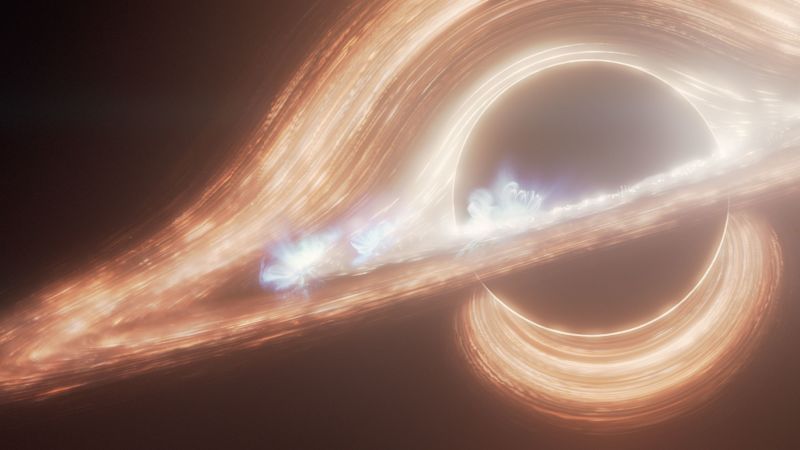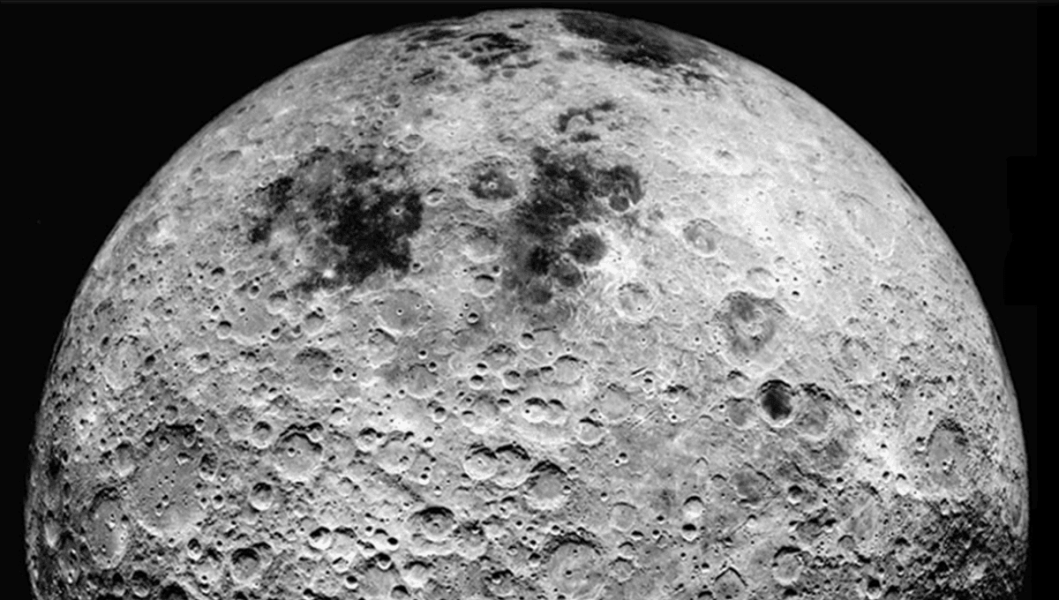Astronomers spot flares of light near the black hole at the center of our galaxy – CNN

Sign up for CNN’s Wonder Theory science newsletter. Explore the universe with news on fascinating discoveries, scientific advancements and more.
Astronomers using the James Webb Space Telescope have spied dynamic flares of light near the supermassive black hole at the center of the Milky Way galaxy. The constant, rapid-fire display includes seconds-long short flashes and longer, blindingly bright flares of light on a daily basis.
The Webb observations mark the longest, most detailed look researchers have been able to make around the Milky Way’s central black hole, called Sagittarius A*, building on past evidence of its highly energetic activity.
While black holes are invisible, the flares unleashed by the swirling disk of hot gas and dust, or accretion disk, that orbits Sagittarius A* resemble a pyrotechnic extravaganza. A study describing the findings was published Tuesday in The Astrophysical Journal Letters.
Astronomers believe the flares are coming from the inner edge of the accretion disk just beyond the black hole’s event horizon, or the area around a black hole where the pull of gravity is so strong that not even light can escape, according to NASA.
“In our data, we saw constantly changing, bubbling brightness,” said lead study author Farhad Yusef-Zadeh, a professor of physics and astronomy at Northwestern University’s Weinberg College of Arts and Sciences, in a statement. “And then boom! A big burst of brightness suddenly popped up. Then, it calmed down again. We couldn’t find a pattern in this activity. It appears to be random. The activity profile of this black hole was new and exciting every time that we looked at it.”
The observations could shed light on how black holes behave and the ways they feed on their surroundings.
The strong, gravitational influence of black holes pulls in gas and dust from any celestial object that wanders too close. The gas and dust swirl together at high speeds, forming the accretion disk that feeds the black hole. The rapid movement of the material causes it to heat up, releasing energy in the form of radiation as well as jets of material that don’t make it into the black hole.
The radiation and jets can change the way gas is distributed throughout galaxies and feed the formation of stars, which is why supermassive black holes are regarded as giant engines at the centers of galaxies.
Yusef-Zadeh and his colleagues observed Sagittarius A*, also called Sgr A*, for 48 hours over the course of one year in eight to 10-hour increments, using Webb’s Near-Infrared Camera to track the black hole’s activity. The team spied five to six big flares a day as well as smaller flashes of light in between.
“Flares are expected to happen in essentially all supermassive black holes, but our black hole is unique,” Yusef-Zadeh said. “It is always bubbling with activity and never seems to reach a steady state. We observed the black hole multiple times throughout 2023 and 2024, and we noticed changes in every observation. We saw something different each time, which is really remarkable.”
Related article
Webb telescope spots six rogue worlds within a glowing cosmic cloud
The variability of the black hole’s activity is likely due to the random nature of the material flowing into the accretion disk, Yusef-Zadeh said.
The team believes the short bursts of light are created by minor, turbulent fluctuations within the accretion disk that could squeeze hot, energetic gas called plasma and cause a flash of radiation.
“It’s similar to how the Sun’s magnetic field gathers together, compresses, and then erupts a solar flare,” Yusef-Zadeh said in a statement. “Of course, the processes are more dramatic because the environment around a black hole is much more energetic and much more extreme.”
Meanwhile, the longer, bigger flares may occur due to magnetic reconnection events, or when two different magnetic fields collide near the black hole and release energetic particles moving near the speed of light.
“A magnetic reconnection event is like a spark of static electricity, which, in a sense, also is an ‘electric reconnection,’” Yusef-Zadeh said.
Webb’s capabilities enabled the team to observe the black hole’s flaring across two different wavelengths of light simultaneously.
“(It was like) seeing the world in color versus in black and white, and (we) found rainbows,” Yusef-Zadeh said. “This tells you about the nature of flaring activity and the physical characteristics of the radiation mechanism, the magnetic field and the density of flares more directly.”
The observations provide a deeper look at how the black hole’s activity varies in brightness over time, said Tuan Do, associate professor in the physics and astronomy department and deputy director of the Galactic Center Group at UCLA.
Do was not involved in this study but has led research on Sagittarius A* in the past, including when the black hole showcased unusual activity in 2019.
“Sgr A* got about half as bright in the new data as was seen in 2019, so I think that 2019 is still unusually active for the black hole,” Do said. “The black hole and its environment (are) always changing though so we are never sure what we’ll find! This is what makes observations of the galactic center so exciting, even though we’ve stared at this spot in the sky for decades now.”
Related article
Massive jets of material shooting from a black hole dwarf even the largest galaxies, scientists say
When the authors of the latest study observed the two different wavelengths of light from the black hole simultaneously, they realized the shorter wavelength changed in brightness just before the longer wavelength. The observation suggested that as the particles spiral around magnetic field lines, they lose energy more quickly.
The changes in brightness have been noted in previous research and recent complementary data from the Mid-Infrared Instrument on the Webb telescope and other observatories.
“I think the next big step would be to try to connect these different data sources together to form a fuller picture of the physics of the environment around the supermassive black hole,” Do said.
The new study also confirms the black hole has “non-stop variability,” as previously observed, said Mark Morris, distinguished research professor in the department of physics and astronomy at UCLA. Morris was not involved in the new study.
“X-ray astronomers see reasonably strong evidence that in the last few hundred years, there has been at least one, maybe two instances of enormous flares taking place,” Morris said via email, “with intensities (10,000 to 100,000) times larger than anything we’ve seen in the last quarter century that we have been closely examining Sgr A*.”
What might have caused these flares? Astronomers still don’t know, but it’s possible the black hole gobbled up a planet a few hundred years ago, Morris said.
Related article
Largest celestial object of its kind discovered in the distant universe
When the sun releases solar storms, scientists worry because such activity can potentially affect GPS, communications and the power grid on Earth. But at 25,000 light-years away, the highly energetic and variable activity of the Milky Way’s central black hole isn’t a concern, Morris said.
However, the Webb telescope observations allow researchers to understand what kind of “storms” are created when matter is compressed and heated as it is drawn toward the black hole.
“Beyond pure interest in the most dazzling fireworks that the universe can produce, those fireworks can have a profound effect on the evolution of the galaxies that they are in,” Morris said. “They can provoke or impede star formation on large scales, they can remove gas and clear out galaxies, leaving them unable to form stars.”
The study authors don’t believe the black hole was experiencing an unusual spike in activity, but they want to observe Sagittarius A* for an uninterrupted 24 hours to be sure.
“We also can see if these flares show periodicity (or repeat themselves) or if they are truly random,” Yusef-Zadeh said.
Astronomers still don’t know how fast Sagittarius A* is spinning as it gobbles up matter, but longer observations could provide the data necessary to find the answer.
Ultimately, more data from Webb observations of Sagittarius A* could help astronomers simulate how accretion disks behave around black holes, as well as comparing the behaviors of less energetically active, black holes with more active ones.
© 2025 Cable News Network. A Warner Bros. Discovery Company. All Rights Reserved. CNN Sans ™ & © 2016 Cable News Network.
Source: https://www.cnn.com/2025/02/19/science/milky-way-black-hole-flickers-webb/index.html






